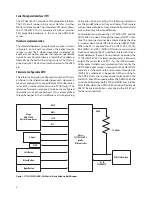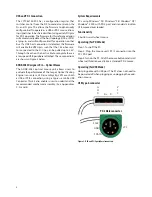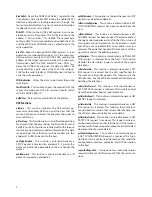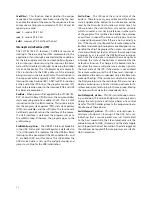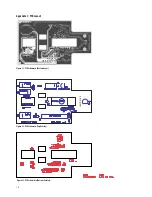
4
Figure 3. USB and PS/2 peripheral connectors.
USB and PS/2 Connection
The CY7C63743-PXC has a configuration register that
switches control from the SIE to manual control on the
D+ and D- pins. This allows the fi rmware to dynamically
confi gure itself to operate as a USB or PS/2 mouse, allow-
ing signal lines to be shared without using extra GPIO pins
for PS/2 operation. The fi rmware for this reference design
will automatically detect the host topology (USB or PS/2)
at plug-in, and will confi gure itself for operation on that
bus. If a USB host connection is detected, the fi rmware
will enable the VREG pin, such that the 1.3k ohm resis-
tor connected to the D- line, can be pulled up to 3.3V.
Through this action, the host is able to recognize there is
a lowspeed USB peripheral attached. These connections
are shown in Figure 3 below.
ADNK-3083 Designer’s Kit — Optical Mouse
The ADNK-3083 optical mouse unit allows users to
evaluate the performance of the Avago’s Optical Tracking
Engine (sensor, lens, LED assembly clip, LED) over both
a USB or PS/2 connection, using a Cypress enCoRe USB
Controller. This kit also enables users to understand the
recommended mechanical assembly. (See Appendices
C, D, and E).
System Requirements
PCs using Windows® 95/ Windows®
98/ Windows®
NT/
Windows® 2000 with PS/2 port and standard 3-button
USB mouse driver loaded.
Functionality
3-button, scroll wheel mouse.
Operating (For PS/2 Mode)
Step 1: Turn off the PC.
Step 2: Plug the mouse unit’s PS/2 connector into the
PC’s PS/2 port.
Step 3: Turn on the PC. All of the mouse buttons and scroll
wheel will function exactly like a standard PS/2 mouse.
Operating (For USB Mode)
Hot pluggable with USB port. The PC does not need to
be powered off when plugging or unplugging the evalu-
ation mouse.
USB type-A connector
VCC
SCLK
GND
SDATA
G
N
D
V
C
C
D+
D-
PS/2 Male connector



